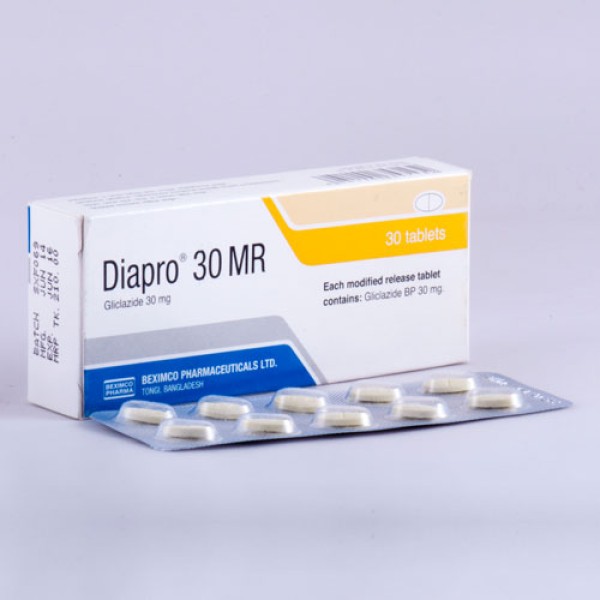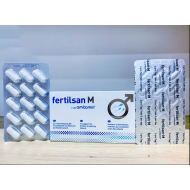
- Stock: In Stock
- Brand: Beximco Pharmaceutical
- Product ID: Gliclazide 30 mg Tablet
100% Secure Payment

This Item is for pre order
What Diapro® MR is and what it is used for?
Gliclazide is a second generation sulfonylurea that has hypoglycemic and potentially useful hemobiological properties. It stimulates the influx of calcium ions into pancreatic beta cells and as a result increases insulin secretion. Moreover, in vivo studies have demonstrated changes in thrombin-induced platelet aggregation in NIDDM patients treated with gliclazide. Non-insulin dependent diabetes mellitus (type-II) when dietary modification has failed.
Before you take Diapro® MR
High Risk Groups
Neonates : The drug is not used in neonates
Nursing mothers : The drug should not be used by breast-feeding mothers.
Children : Gliclazide is contraindicated in children
Pregnant women : Gliclazide, as other sulfonylurea, is contraindicated for use in pregnant women. No teratological changes have been shown in animals or human, but diabetes can be controlled more tightly in pregnancy by insulin than by oral hypoglycemic agents.
Elderly : All sulfonylureas should be used with caution in the elderly because of the greater likelihood of their missing meals and the more severe outcome of significant hypoglycemia.
Concurrent disease : Definite hepatic disease should contraindicate the use of Gliclazide, since it is almost completely metabolized in the liver. Renal disease does not appear significantly to alter the pharmacokinetics, although it may be wise to limit the maximum dose when the serum creatinine starts to rise.
Drug Interactions
Potentially hazardous interactions - These may be divided into those which will tend to increase the hypoglycemic effect and those tending to oppose it. In the first category come drugs which displace the sulfonylurea from protein binding, such as aspirin, non-steroidal anti-inflammatory drugs, phenylbutazone, clofibrate, sulfonamides and coumarin anticoagulants, or which inhibit, hepatic microsomal enzymes, for example cimetidine, sulfonamides, imidazole antifungal agents and the monoamine oxidase inhibitors (MAOI), which may increase the hypoglycemic effect of Gliclazide. Any effects, which result from protein-binding displacement, are transient, lasting from 12-24 hrs. Regular concomitant doses of these agents together with a constant dose of Gliclazide would not cause problems.
The hypoglycemic action of sulfonylureas may be opposed by the induction of hepatic enzymes, which metabolize the drug causing lower plasma concentrations and less hypoglycemic effect. Common inducers include rifampicin, barbiturates, phenytoin and alcohol, or by drugs that inhibit the release or action of insulin, e.g. thiazide diuretics, dizoxide, glucocorticoids, estrogens or sympathomimetic drugs. Early symptoms of hypoglycemia such as tremor, sweating and tachycardia may be masked by beta-adrenoreceptor blocking drugs, such as propranolol allowing severe hypoglycemic episodes without preceding warning symptoms. If beta-adrenoreceptor blocking drugs are required the moreselective types, such as metoprolol or atenolol, are preferred in the diabetic patient.
How to take Diapro® MR
Initially 40-80 mg daily, adjusted according to response; up to 160 mg as a single dose, with breakfast; higher doses divided; maximum 320 mg daily. Switching from Gliclazide 80 mg tablets to Gliclazide 30 mg modified release tablets. 1 tablet of Gliclazide 80 mg is comparable to 1 tablet of Gliclazide 30 mg modified release tablet. Consequently the switch can be performed provided a careful blood monitoring.
Possible side effects
Potentially life-threatening effects - All hypoglycemic agents have the potential to cause severe hypoglycemia and may cause severe brain damage or death. Gliclazide used in standard dose is less likely than glyburide to cause hypoglycemia. Hypoglycemia may be favored by concurrent conditions such as hepatic and renal disease, malnutrition, anorexia, senility, alcohol intoxication or adrenal and pituitary insufficiency.
Severe or irreversible adverse effects - Approximately 2% of patients have been withdrawn from therapy because of adverse reactions, namely hypoglycemia (overdose effect), gastrointestinal disturbances and dermatological reactions.
Symptomatic adverse effects - Side effects of Gliclazide treatment are similar to those of other sulfonylureas. Headache, gastrointestinal upsets, nausea and dizziness have been reported and skin reactions, including rash, pruritus, erythema and bullous eruptions may occur. Abnormalities of liver function are not uncommon.
How to store Diapro® MR
Keep in a cool & dry place. Protect from light. Keep out of the reach of children.



























%20Pvt.%20Ltd./Movicol-Oral-Powder-190x190.jpg)
